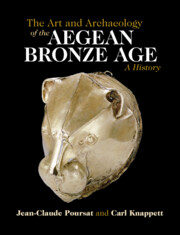Book contents
- The Art and Archaeology of the Aegean Bronze Age
- The Art and Archaeology of the Aegean Bronze Age
- Copyright page
- Contents
- Figures
- Introduction
- Part I Aegean Neolithic Art
- Part II The Art of the Aegean Early Bronze Age
- Part III Aegean Art in the Cretan First Palace Period
- Part IV Aegean Art in the Second Palace Period
- Part V Aegean Art in the Cretan Second Palace Period
- Chapter 26 Artworks in Context
- Chapter 27 Funerary Architecture
- Chapter 28 Metalwork
- Chapter 29 Creto-Mycenaean Glyptic
- Chapter 30 Other Mycenaean Relief Arts
- Chapter 31 Mycenaean Pottery of LH I–IIA
- Chapter 32 General Remarks
- Part VI Aegean Art in the Final Palatial Period of Knossos
- Part VII Aegean Art of the Mainland Mycenaean Palatial Period
- Part VIII Aegean Art at the End of the Bronze Age
- Afterword Aegean Art Through Forgers’ Eyes
- References
- Index
- Plate Section (PDF Only)
- References
Chapter 30 - Other Mycenaean Relief Arts
Wood, Bone, Ivory, Stone, and Faience
from Part V - Aegean Art in the Cretan Second Palace Period
Published online by Cambridge University Press: 19 May 2022
- The Art and Archaeology of the Aegean Bronze Age
- The Art and Archaeology of the Aegean Bronze Age
- Copyright page
- Contents
- Figures
- Introduction
- Part I Aegean Neolithic Art
- Part II The Art of the Aegean Early Bronze Age
- Part III Aegean Art in the Cretan First Palace Period
- Part IV Aegean Art in the Second Palace Period
- Part V Aegean Art in the Cretan Second Palace Period
- Chapter 26 Artworks in Context
- Chapter 27 Funerary Architecture
- Chapter 28 Metalwork
- Chapter 29 Creto-Mycenaean Glyptic
- Chapter 30 Other Mycenaean Relief Arts
- Chapter 31 Mycenaean Pottery of LH I–IIA
- Chapter 32 General Remarks
- Part VI Aegean Art in the Final Palatial Period of Knossos
- Part VII Aegean Art of the Mainland Mycenaean Palatial Period
- Part VIII Aegean Art at the End of the Bronze Age
- Afterword Aegean Art Through Forgers’ Eyes
- References
- Index
- Plate Section (PDF Only)
- References
Summary
The Linear B tablets from the palace of Pylos make mention of pieces of wooden furniture: tables, thrones, and stools. But very few wooden objects have been found in Greece (O. Krzyszkowska, in Herrmann 1996, 85–103), and because there is such little evidence we have surely underestimated the importance of wood carving in Mycenaean art.
The best-preserved piece of evidence, from the Shaft Graves of Mycenae, is a sycamore box (Poursat 1977a, n° 215), whose sides are fixed with tenons and mortises. It is adorned with ivory plinths that represent stepped cornices, on which are placed relief dogs carved in wood (AE2, fig. 50). We should dismiss the hypothesis that this is an Egyptian import (Persson 1931, 179–81; contra Karo 1930–3, 319); this type of architectural cornice does not depict house roofs in the Egyptian style, but a form that does exist on Minoan relief frescoes.
- Type
- Chapter
- Information
- The Art and Archaeology of the Aegean Bronze AgeA History, pp. 307 - 313Publisher: Cambridge University PressPrint publication year: 2022

